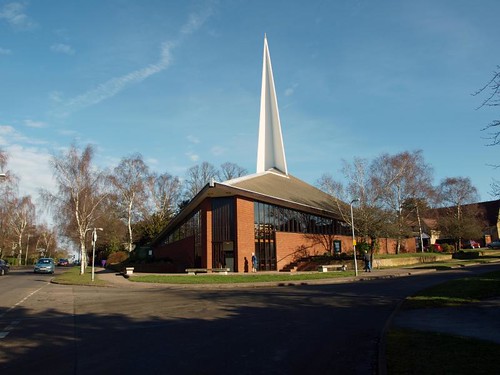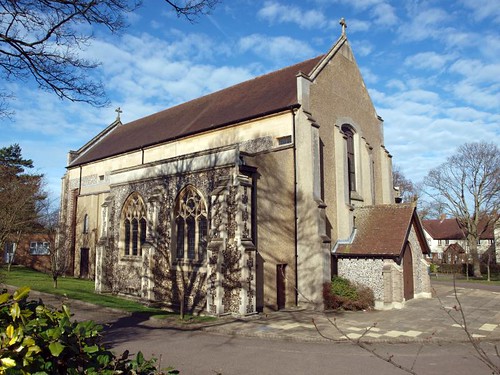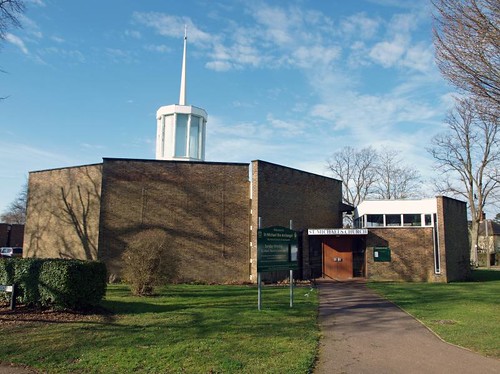Not to my taste but the original Garden City is actually rather well planned and you can see what the movement was trying to achieve but I have to say that I found it all rather soulless and not helped by later development. Strangely, or perhaps not, I felt I was in a set for EM Forster's Howards End - an oddly transposed piece of the worst of Surrey or Cheshire imposed on Hertfordshire, it seems to me a shame that the Garden Citys' first attempt didn't quite work.
Of the three churches I visited only St Paul should have qualified under normal rules, however I think I made a mistake in not entering St George, the other two, St Paul and St Michael, were lnk.
Letchworth, to nearly all those who know the name in Britain and abroad, means a garden city, in fact the first garden city ever built. The adventure began in 1903, several years before the Hampstead Garden Suburb and seventeen before Welwyn. The idea of the garden city came from Ebenezer Howard’s book of 1898. To translate the idea into visual terms Barry Parker and Raymond Unwin had to make an organism out of a diagram. In this they succeeded. The Hampstead Garden Suburb makes that even clearer than Letchworth. For Letchworth, as the first exploratory pioneer job, suffered from some initial faults which it has never quite overcome. The principle of the garden city is one of controlled social and architectural structure and controlled growth. Number of inhabitants, type and location of houses, type and location of factories has to be kept in a certain relation to each other, with the result that the town should be an independent and self-sufficient unit. At Letchworth it took long to attract industry, and population consequently did not grow fast enough to justify an architectural display of public buildings as the plan had foreseen them along the large central square or green. In fact the visual failure of Letchworth is that very square, laid out in axis with the station and at right angles to another main axis. Corning from the station one has, as one should have, an initial feeling of urban bustle (a few shopping streets of tallish buildings). But then the square is reached and the public buildings are mostly small, architecturally indifferent, and do not seem to be related to each other (Council Offices by Bennett & Bidwell, Grammar School by Barry Parker). The largest of them, St Francis’ College (by Morley Harder; new extension by L. H. Shazzock) stands in no comprehensible position and represents no scale echoed anywhere else. The domestic architecture of the early years, on the other hand, is eminently convincing. It is very similar to that of the Hampstead Garden Suburb, except that exposed brick is rarer. The style is mostly a free and comfortable Neo-Tudor with gables. The houses are detached or in groups of four. The streets curve, except for the main axes, existing trees are preserved, no garden walls since cut up for green - all principles adopted since for municipal estates. To the younger generation they have thus become a matter of course, but it should not be forgotten that they were for the very first time systematically followed at Letchworth. The old village of Letchworth lies outside the garden city, and it seems a pity that the Parker-Unwin plan did not choose to make use of the church and hall as a centre or sub-centre. It would have meant a welcome break in the architectural uniformity of the small-scale housing (cf., for example, Oxhey).
Letchworth. It is the city built by dreams, the dreams of Ebenezer Howard, who while others talked of garden cities, went out spade in hand and made one. It is worth while to think a little of his story before we come to Letchworth.
He was born in London, tried office life, was private secretary to Dr Parket of the City Temple, went out to Chicago, and then came back to London to find himself disgusted with its slums. He felt as he looked at them like Abraham Lincoln when he looked at slavery, and he decided that if ever an opportunity came he would hit them hard. He saw a city of the future, like a New Jerusalem in a green and pleasant land, where people could live with trees and lawns and flowers about them and feel the wind blowing everywhere.
It was not enough, he said, to think of the town as one magnet and the country as another, pulling different ways; there should be a town-country magnet which would as far as possible combine the advantages of the other two while reducing their disabilities. This Utopia would join beauty of Nature with social opportunity, low rents with high wages, low rates with plenty to do, low prices without sweating, pure air and water with good drainage, bright homes and gardens with no smoke and no slums, and freedom with co-operation. He proceeded to draw plans of such a garden city as he imagined. He set out a site of 5000 acres planned with streets and houses and gardens, with allotments, fruit farms, pastures, woods, water supply, and space for factories and markets as well as for schools and convalescent homes, and all with access to a railway.
Such was the plan, and he handed it over to the critics. They were not silent, nor was he. Having begun the movement on paper he brought it into the public eye by every means within his power. With a dozen friends he formed a Garden City Association. The fruit of his hundreds of public meetings and the clear business like nature of his propositions so convinced the sceptics that three years after the publication of his practical propositions the Letchworth site was purchased for £150,000. That was in 1903. From that time forward, despite jealousies, ridicule, and afterwards the interruption caused by the Great War, the scheme advanced and took continually more concrete shape. After Letchworth came Welwyn, and more remarkable than either, Wythenshawe.
These were all his foster-children, but they had many descendants. Out of his scheme sprang the Town Planning Act. Garden suburbs and garden villages all owe their existence to this man who loved the countryside and wished our people to enjoy it.
Letchworth is perfectly delightful, planned on 1500 acres with a green belt of twice as much round it. It has 30 miles of roads with 7000 trees planted along them in about 50 varieties, and it is so spaced out with fine avenues, quiet walks, squares and gardens and cloisters, that 200 factories make no difference to its rural aspect. It has a shopping centre, a civic centre, residential areas, a museum and a grammar school, and, of course, the old church which was here long before it, when all this place was three small villages. The Icknield Way runs through the centre of the town with a mile-long stretch of almond trees, the beauty of which must be seen in springtime to be believed. It is all hardly more than a generation old, yet nearly 25,000 people have their homes here, among the limes and chestnuts and poplars growing tall and shady. The grass verges and the belt of lovely country, which must never be built on, are an example for all reformers and a rebuke to every slum.
Close to this city of the 20th century is the site of a British settlement of 20 centuries ago; we may see some of the finds from it in the museum, together with Roman and medieval objects and a fine photographic survey of the whole neighbourhood.
The museum, admirably arranged by the well-known naturalist Mr Percival Westell, has in its natural history collection skulls of mammals and birds, eggs and nests, insects, shells, and stones and local fossils of the Chalk Age and the Ice Age. The cases of Bygones are of remarkable interest to students of old Hertfordshire life, and the room of Roman and prehistoric antiquities is constantly growing in a county which has so much history beneath its feet.
But there is an old Letchworth still in existence, aloof from the new. First we come to the timber house with dormer windows which is now the post office, an outpost of 300 years ago; then to a house as old which has been turned into a row of cottages; and then to a screen of great chestnut trees with the 17th-century Hall on one side and a diminutive church with a queer little 16th-century bellcot on the other. A copy of this church has been erected in the garden city, but there is history in these old walls which cannot be repeated.
For 500 years the porch has sheltered a door strengthened with 13th-century ironwork. The nave walls were probably laid by Norman masons though the doorway and the windows are later. The chancel arch seems to have been made new in the 16th century, and the chancel is a medley of the centuries going back to the 13th. Fragments of medieval glass are in two windows. The font bowl has served for 600 years and all that time a bell with Ave Maria written on it before the Reformation has continued to call people to church. Some of the benches were made 500 years ago, and medieval beams are glimpsed through the plaster roof. The brass portrait of a 15th-century rector, Thomas Wyrley, is near the brass portraits of a couple he knew well, William and Isabelle Overbury; and lying on the sill of a window where glows the shield of the Hertfordshire Montfichets is the small stone figure of a knight in chain mail, much worn after more than 600 years. He holds a heart case to show that only his heart was buried here, and he was probably close of kin to Richard Montfichet, one of the 25 barons appointed to see that the liberties won by Magna Carta were not lost.
The old hall, now a hotel, has a fine oak screen 300 years old, and a plaster of the judgement of Paris over a fireplace. It was the home of an eccentric rector who would hold services here to which he would summon giant musical boxes and any wandering minstrels who would add to the din, and it was his fancy to ride up and down the hall on his velocipede after the service, now crashing into the screen, now stopping to hand a jar of snuff round the congregation.
Flickr.
He was born in London, tried office life, was private secretary to Dr Parket of the City Temple, went out to Chicago, and then came back to London to find himself disgusted with its slums. He felt as he looked at them like Abraham Lincoln when he looked at slavery, and he decided that if ever an opportunity came he would hit them hard. He saw a city of the future, like a New Jerusalem in a green and pleasant land, where people could live with trees and lawns and flowers about them and feel the wind blowing everywhere.
It was not enough, he said, to think of the town as one magnet and the country as another, pulling different ways; there should be a town-country magnet which would as far as possible combine the advantages of the other two while reducing their disabilities. This Utopia would join beauty of Nature with social opportunity, low rents with high wages, low rates with plenty to do, low prices without sweating, pure air and water with good drainage, bright homes and gardens with no smoke and no slums, and freedom with co-operation. He proceeded to draw plans of such a garden city as he imagined. He set out a site of 5000 acres planned with streets and houses and gardens, with allotments, fruit farms, pastures, woods, water supply, and space for factories and markets as well as for schools and convalescent homes, and all with access to a railway.
Such was the plan, and he handed it over to the critics. They were not silent, nor was he. Having begun the movement on paper he brought it into the public eye by every means within his power. With a dozen friends he formed a Garden City Association. The fruit of his hundreds of public meetings and the clear business like nature of his propositions so convinced the sceptics that three years after the publication of his practical propositions the Letchworth site was purchased for £150,000. That was in 1903. From that time forward, despite jealousies, ridicule, and afterwards the interruption caused by the Great War, the scheme advanced and took continually more concrete shape. After Letchworth came Welwyn, and more remarkable than either, Wythenshawe.
These were all his foster-children, but they had many descendants. Out of his scheme sprang the Town Planning Act. Garden suburbs and garden villages all owe their existence to this man who loved the countryside and wished our people to enjoy it.
Letchworth is perfectly delightful, planned on 1500 acres with a green belt of twice as much round it. It has 30 miles of roads with 7000 trees planted along them in about 50 varieties, and it is so spaced out with fine avenues, quiet walks, squares and gardens and cloisters, that 200 factories make no difference to its rural aspect. It has a shopping centre, a civic centre, residential areas, a museum and a grammar school, and, of course, the old church which was here long before it, when all this place was three small villages. The Icknield Way runs through the centre of the town with a mile-long stretch of almond trees, the beauty of which must be seen in springtime to be believed. It is all hardly more than a generation old, yet nearly 25,000 people have their homes here, among the limes and chestnuts and poplars growing tall and shady. The grass verges and the belt of lovely country, which must never be built on, are an example for all reformers and a rebuke to every slum.
Close to this city of the 20th century is the site of a British settlement of 20 centuries ago; we may see some of the finds from it in the museum, together with Roman and medieval objects and a fine photographic survey of the whole neighbourhood.
The museum, admirably arranged by the well-known naturalist Mr Percival Westell, has in its natural history collection skulls of mammals and birds, eggs and nests, insects, shells, and stones and local fossils of the Chalk Age and the Ice Age. The cases of Bygones are of remarkable interest to students of old Hertfordshire life, and the room of Roman and prehistoric antiquities is constantly growing in a county which has so much history beneath its feet.
But there is an old Letchworth still in existence, aloof from the new. First we come to the timber house with dormer windows which is now the post office, an outpost of 300 years ago; then to a house as old which has been turned into a row of cottages; and then to a screen of great chestnut trees with the 17th-century Hall on one side and a diminutive church with a queer little 16th-century bellcot on the other. A copy of this church has been erected in the garden city, but there is history in these old walls which cannot be repeated.
For 500 years the porch has sheltered a door strengthened with 13th-century ironwork. The nave walls were probably laid by Norman masons though the doorway and the windows are later. The chancel arch seems to have been made new in the 16th century, and the chancel is a medley of the centuries going back to the 13th. Fragments of medieval glass are in two windows. The font bowl has served for 600 years and all that time a bell with Ave Maria written on it before the Reformation has continued to call people to church. Some of the benches were made 500 years ago, and medieval beams are glimpsed through the plaster roof. The brass portrait of a 15th-century rector, Thomas Wyrley, is near the brass portraits of a couple he knew well, William and Isabelle Overbury; and lying on the sill of a window where glows the shield of the Hertfordshire Montfichets is the small stone figure of a knight in chain mail, much worn after more than 600 years. He holds a heart case to show that only his heart was buried here, and he was probably close of kin to Richard Montfichet, one of the 25 barons appointed to see that the liberties won by Magna Carta were not lost.
The old hall, now a hotel, has a fine oak screen 300 years old, and a plaster of the judgement of Paris over a fireplace. It was the home of an eccentric rector who would hold services here to which he would summon giant musical boxes and any wandering minstrels who would add to the din, and it was his fancy to ride up and down the hall on his velocipede after the service, now crashing into the screen, now stopping to hand a jar of snuff round the congregation.
Flickr.



No comments:
Post a Comment